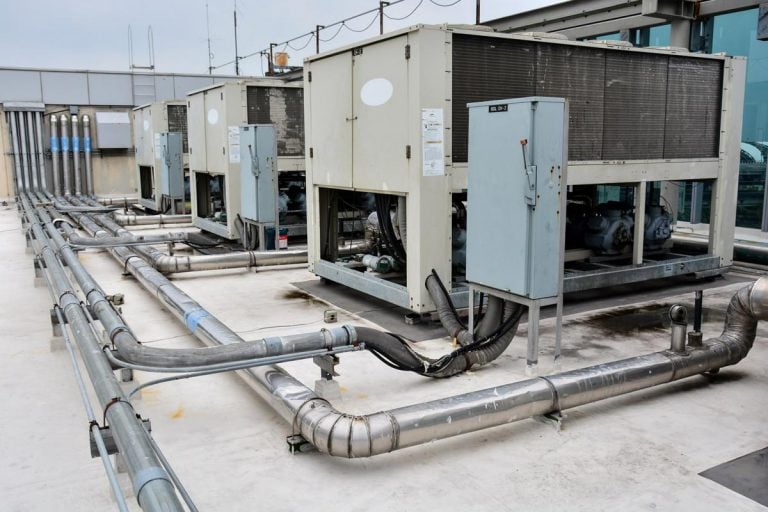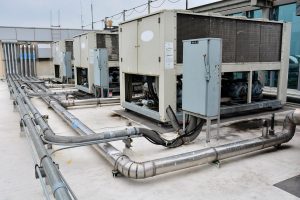It’s almost Summertime again and the need for air conditioning in buildings is greater than ever. Of course, HVAC doesn’t tackle cooling systems alone, as we mentioned in a previous blog, heating and ventilation are also essential in maintaining good air quality in the building so that occupants can work healthily and happily. So if you have a construction project launching soon, this is your guide to the right HVAC systems. This blog also covers essential tips for first time HVAC subcontractors on their first-ever installation.
Heating and cooling are two of the main enemies of wise energy consumption in buildings. During the summer, cooling can use power at a ridiculous level while heating in winter also does the same. If they aren’t properly installed or chosen, then they can drive up the occupants’ energy bill way too quickly.
In fact, statistics show how HVAC consumes about 48% of the total bill used in a typical American home. Looking at it, the use of HVAC makes up almost half of the total bill paid monthly. And it can’t be avoided most especially during the summer and winter.
The more modern HVAC units are already energy-efficient. They may be more expensive but the savings accumulated in the long run can make up for the initial cost.
Being an HVAC subcontractor, it is your responsibility to make the client realize this advantage. Protecting your credibility too, you’d want to have a smooth and worry-free installation where you wish to skip the part where you feel guilty about making a poor recommendation.
Being a successful HVAC subcontractor in this saturated industry isn’t that difficult. Even startups can climb their way up fast to being the most preferred HVAC installer when you do your business the right way.
But before we get to those tips on how to become one, let’s first look into the reasons why every building in the United States should already have their own HVAC installed.
Importance of HVAC in Buildings
HVAC units, like we already discussed, are systems to regulate the flow of air, heat, and ventilation in a building. Overall, the main objective of having an HVAC in a building is to make occupants in a building feel comfortable for them to become healthier, happier, and more productive. And you know that these are what employers need their workers to become if they want their businesses to be more profitable.
Moreover, buildings need HVAC installed in them because:
- HVAC systems are used for controlling the overall climate in a building. This means that when it’s warm outside, it balances the temperature to make the inside cooler or warmer during the cold season. The air conditioner works during the warmer days while boilers or heaters are turned on during the colder days.
- HVAC fosters enhanced productivity in offices as they feel comfortable. And when they are comfortable, their minds and body tend to function better, leading them to deliver better job results.
- HVAC improves air quality in the building, helping make it appropriate for human breathing and comfort. It reduces humidity so occupants can enjoy a better atmosphere. This is most especially useful in buildings or underground spaces where ventilation is limited.
- HVAC systems help you achieve more savings when it comes to energy bills. Gone are the days where we used fans and old-school air conditioners to feel cooler inside a building or fireplaces to keep us warmer. We also don’t have to waste energy when we forget to turn them off at night because modern HVACs are now automatic. Schedules and conditions can now be set. For instance, the newer airconditioner will stop working when it senses the temperature desired is already achieved and will start working again when it senses a drop in temperature. Some units can even tell when the occupants already left the premises and automatically shuts down. Since the air conditioner won’t work continuously, more energy can be saved.
Looking at these reasons, besides comfort, energy-saving is another benefit to enjoy from using the proper HVAC system.
That said, you have to know that not all HVAC systems are created equally. So as a subcontractor, you’ll have to learn all the units available in the market, which applications they should be used, and when they should be recommended.
It can take a lot of work to familiarize yourself with all the HVAC units as new models are being launched every now and then. But taking the extra mile to master them will likely lead your HVAC business to its success.
Types of HVAC Systems in Buildings
The installation of HVAC can be decided as early as the planning stage of construction since the placement of ducts and pipes for air and the pipes should be prepared before every floor gets a ceiling.
Review the building design with the planner and take a tour at the site for checking the air condition. Then the next step should be choosing the right HVAC system to use.
You may encounter different models in the market but they should belong to one of these HVAC system types:
1.Constant Volume System
The constant volume HVAC system is usually used in larger buildings because of its ability to regulate constant air flow. It cools or heats the air as needed. It draws air from the outside and through the ducts attached to it.
This is a preferred system by most commercial buildings where there is a lot of foot traffic like malls, airports, supermarkets, and so on.
- Variable Volume System
The variable volume HVAC system is another option for commercial building usage. Its main function is to increase or decrease the flow of air which has been pre-heated or cooled by the unit before being pushed through the ducts and into the building.
- Hybrid Heat Split System
A hybrid heat split system is composed mainly of ducts, furnaces, and evaporator coils. It is also equipped with a heat pump for heating and cooling. But unlike the traditional split system, a hybrid unit uses electricity to start cooling or heating activities.
- Packaged Heating and Cooling System
Like its name suggests, the packaged heating and cooling system is extremely compact. It combines heating and cooling in one unit and is a great option for small spaces like individual office rooms, a meeting room, or house rooms.
- Heating and Air Conditioning Split System
This system is most commonly used in small buildings or houses. Its components include cooling refrigerant and gas furnaces and can be controlled by a thermostat.
- Heat Pumps
Heat pumps can be used in buildings and homes. They are both energy-efficient and environmental-friendly, hence a popular choice for practical owners. These units extract the heat from cold air, process them with a refrigerant, and pump out heat into the interior of a building.
- Forced Air System
The forced air system works by sucking the air out of a building, cools or heats the air, and pushes it back to the inside through the ducts. Its components include fans, air conditioner, and furnace coils.
- Multiple Zone HVAC System
This type of HVAC system is excellent for offices. Various controls are provided so you can adjust the temperature exactly how you want it to be. It isn’t centralized so you can change the temperature in one room without affecting the temperature in other rooms.
As you can see, HVAC has a lot of variations so it’s not that simple to recommend a unit. The basic understanding of these HVAC systems will help you make an informed decision. And as we mentioned earlier, the other keys to choosing the right type of HVAC to install is to review the building design, check the objectives, and inspect the site.
Tips on Achieving a Profitable HVAC Subcontractor Business
Having an HVAC system is almost a requisite in every building project. That means HVAC contractors have a pretty high chance of making their startup business profitable more quickly.
Apart from educating yourself with the systems used in HVAC installation, here are the other things we suggest you do to grow your HVAC subcontracting business in no time:
- Use a Reputable HVAC Supplier
This is important. We mentioned earlier about HVAC systems not being equal and it goes the same with suppliers. Some startups try to win projects by offering the lowest bid, but the truth is, clients can fund modern HVAC since it serves as one of the main selling points of the project.
It’s not always worth saving money to go with the cheapest. There will be a lot of sales and you can talk suppliers out for some discounts but always make sure that they are trustworthy and that their products are authentic and working. If you are not careful, you will end up spending your own money on repairs or repeat installation.
Always get a new unit too. Second-hand HVAC units may be less efficient and consume more energy.
- Improve Your Scheduling Efficiency
Now that you know how to choose the right HVAC unit and supplier, your success now depends on your performance at the site and it all starts with efficient scheduling of projects. One project may take between 3 and 10 members only to finish so it’s okay to accept several contracts at the same time. However, you have to make sure that you can manage all the members you send out to work and won’t get plans and instructions mixed up.
Home projects are typically quicker to finish. It may only take your crew a day or two to install a system. But bigger projects like commercial or industrial buildings may take at least a week to a month, depending on the complexity of the structure and the system chosen.
Using a custom project management software designed for construction trades like Pro Crew Schedule can help you handle these installation schedules and keep the workflow smooth in both sites.
- Collect deposits
When you are just starting with your HVAC subcontracting business, you need to have a cash flow to keep the business running and getting deposits or downpayments from your clients will help speed it up.
These deposits are for purchasing the tools, equipment, unit, and materials you need for the project. After taking a couple of projects, there will be no more buying of new tools or equipment so the budget intended for those will now become rental fees of your own stuff.
- Improve your Invoicing
After deposits, the next task left for you to do is invoicing. Make sure to create a solid invoicing strategy, otherwise, you will end getting unpaid.
During the signing of contracts, make your invoicing schedule clear to your client. You can schedule the next payment when 50% of the work is already done and the last when the project is completed. But of course, this suggestion is for building projects. For home installations, you can be more relaxed as it only takes at most 2 days for setting up a unit.
You can’t always control when clients will pay you. But you can always encourage them to pay on time by sending invoices and timely follow-ups.
Key Takeaways
HVAC subcontracting can be a very profitable business. By constantly educating yourself with the current system trends, scouting for the right suppliers you can work with for longterm, and practicing practical ways to be more profitable, you will be able to see your small company grow into a preferred firm in no time.
Start by organizing your business with a simple project management software like Pro Crew Schedule. Request a demo today and discover how its features can help make your field and office work easier and more efficient.





